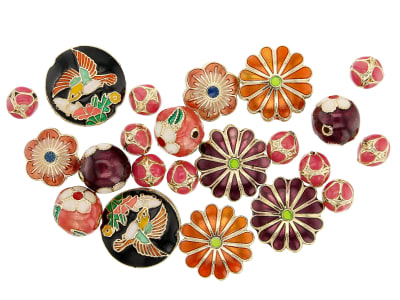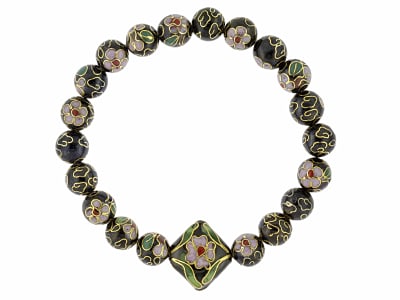Cloisonné is an enameling or inlay technique used to decorate jewelry or other metallic objects. The enamel or gemstones are applied to create patterns or geometric designs. The colored material is placed in compartments or in between raised strips of metal. The enamel is created adding a silica source like sand or pulverized flint with lead oxide, potash or soda ash, and a metallic oxide for color. The metal oxides frequently used were Cobalt to produce blue, iron for red or brown colors, copper is to create green shades, and purple is due to manganese. The raw ingredients are heated together to produce a colored glass. The glass is then powered and mixed with water to produce a paste. The paste is then added into a prepared metal chamber and heated until the mixture melts and bonds with the metal. The piece is then ground and polished to produce a smooth surface. The earliest examples of the technique can be found in ancient Egypt. Cloisonné has been used as a decorative technique by many cultures around the globe.
General Information
Cloisonne Colors
-
 Bi-color
Bi-color -
 Black
Black -
 Blue
Blue -
 Brown
Brown -
 Gray
Gray -
 Green
Green -
 Multi-color
Multi-color -
 Orange
Orange -
 Pink
Pink -
 Purple
Purple -
 Red
Red -
 White
White -
 Yellow
Yellow
Countries of Origin
Unknown
History
The earliest known example of the use of cloisonné are the pectoral jewels worn by the Egyptian Pharaohs. In 1952 six gold rings with cloisonné enamel were found in a Mycenaean tomb at Kouklia, Cyprus. The rings dated to between 1230-1050 B.C. After this excavation a Mycenaean Royal Gold Scepter decorated with cloisonné enamel was discovered in a tomb in Kourion, Cyprus. The scepter dates to eleventh century. It is thought the technique spread from the Byzantine and Mycenaean Royal Courts to Persia, Europe, and Asia. It was a popular artform the during Ming (1368-1644) and Qing Dynasties (1644-1911) in China. The artform was frequently used during the Edo (1603-1868) and Meiji periods (1868-1912) in Japan. After the London Exhibition of 1862 Lucien Falize, the French jeweler that launched the Art Nouveau movement, was inspired by the Japanese and Indian enamels on display at the exhibition and he started using the cloisonné technique in his own jewelry. Fabergé goldsmiths produced many decorative items using the technique for the Romanov court in the late 1800’s.
Care
Avoid scratching

